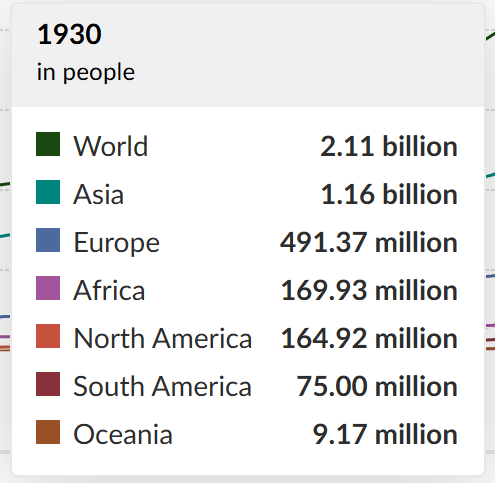Interesting post from Michael Pettis in Bluesky. Because in Vic3 we are almost always increasing our POPs wages, it is also very difficult to increase trade.
In Vic3 only an increase of World population without internal consumption (no peasants, no buildings) could fuel international demand if at the same time the nations producing goods would not increase their internal consumption
7/10 I am not sure why this is so hard to understand. The reward to any country for productivity growth is not trade surpluses. It is higher wages that allow domestic households to increase their living standards in line with the increase in productivity.

bsky.app
Interesting, and this touches on another problem with Vic3's simulation that is pop growth.
Historically, world population reached 2.11B in 1930 and 2.33B in 1940:
source
In Vic3, I never see it reach even close to 2B, in my experience it ranges from 1.5-1.7B in the 1930s.
That's a very stark difference, the world id missing some 20-30% of its population! That's between one third and one fifth!
And of course this has very profound effects in the game, when the main loop revolves around having available labor to keep expanding your industries, these pops leave a huge hole in your potential growth.
And this leads to another issue very prevalent in the late game, the near permanent full-employment state we face (there are outliers, but in most economies, if you've played your cards right, many of your building will have huge vacancies which cannot be filled).
The end result is higher wages, lower profitability, and less comparative advantage, which you pointed out, but there's also another factor here: higher wages increases domestic consumption, driving prices up and decreasing trade potential.
It should be very difficult or near impossible to keep this full-employment state, maybe it should stay between 5-10% with possibility to push above/below that in very negative/positive cases, and pop growth is definitely a big part of this equation.
Sort of off topic, but I've tried to fiddle with defines and ran test games, but even doubling overall growth rate I didn't see very significant results. I'm clearly missing something (maybe I should look more into literacy effects), but after a whole week running test games, I decided to give up for now.
bsky.app



